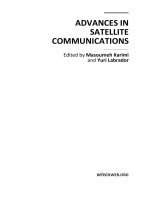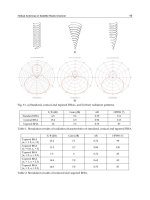Resource Management in Satellite Networks part 1 doc
Bạn đang xem bản rút gọn của tài liệu. Xem và tải ngay bản đầy đủ của tài liệu tại đây (235.8 KB, 10 trang )
Resource Management in Satellite
Networks
Optimization and Cross-Layer Design
This page intentionally left blank
Resource Management in Satellite
Networks
Optimization and Cross-Layer Design
Giovanni Giambene
Università degli Studi di Siena
1 3
Giovanni Giambene
Dipartimento di Ingegneria Dell’Informazione
Università degli Studi di Siena
Via Roma, 56
53100 Siena
ITALY
9 8 7 6 5 4 3 2 1
springer.com
written permission of the publisher (Springer Science+Business Media, LLC, 233 Spring Street, New
York, NY 10013, USA), except for brief excerpts in connection with reviews or scholarly analysis.
Use in connection with any form of information storage and retrieval, electronic adaptation, comp-
uter software, or by similar or dissimilar methodology now know or hereafter developed is for-
Library of Congress Control Number: 2007922349
ISBN 0-387-36897-3 e-ISBN 0-387-53991-3
ISBN 978-0-387-36897-9 e-ISBN 978-0-387-53991-1
Printed on acid-free paper.
¤ 2007 Springer Science+Business Media, LLC
even if they are not identified as such, is not to be taken as an expression of opinion as to whether or
not they are subject to proprietary rights.
All rights reserved. This work may not be translated or copied in whole or in part without the
bidden. The use in this publication of trade names, trademarks, service marks and similar terms,
Acknowledgements
The volume Editor and the authors would like to acknowledge
the FP6 EU Network of Excellence SatNEx II (IST-027393) and,
in particular, activities ja2230&2330 for the research work as the
basis of this book.
Preface
Nowadays, satellites are used for a variety of purposes, including sensors and
data collection, weather, maritime navigation and timing, Earth observation,
and communications. In particular, satellite transmissions have an important
role in telephone communications, television broadcasting, computer commu-
nications as well as navigation.
The use of satellites for communications was a brilliant idea of Arthur C.
Clarke who wrote a famous article in October 1945 in the Wireless World jour-
nal, entitled “Extra Terrestrial Relays - Can Rocket Stations Give Worldwide
Coverage?” that described the use of manned satellites in orbits at 35,800
km altitude, thus having synchronous motion with respect to a point on the
Earth. This article was the basis for the use of GEOstationary (GEO) satel-
lites for telecommunications. Subsequently, he also proved the usefulness of
satellites as compared to transatlantic telephone cables.
Satellite communications deserve the special merit to allow connecting
people at great distances by using the same (homogeneous) communication
system and technology. Other very significant advantages of the satellite ap-
proach are: (i) easy fruition of both broadcast and multicast high bit-rate
multimedia services; (ii) provision of backup communication services for users
on a global scale (this feature is very important for emergency scenarios and
disaster relief activities); (iii) provision of services in areas that could not be
reached by terrestrial infrastructures; (iv) support of high-mobility users.
Three broad areas where satellites can be employed are: fixed satellite
service, broadcast satellite service, and mobile satellite service. Particularly
relevant is the significant global success of broadcast satellite services for both
analogue and digital audio/TV by exploiting the inherent wide coverage area
of GEO satellites. At the beginning of the 21
st
century more than 70 million
European homes watch TV programs through direct satellite reception or
through cable distribution systems.
New satellite system architectures are being envisaged to be fully IP-based
and support digital video broadcasting and return channel protocols, such as
DVB-S, DVB-S2 and DVB-RCS. Trends in telecommunications indicate that
viii Preface
four growing market areas are messaging and navigation services, mobility ser-
vices, video delivery services, and interactive multimedia services. In addition
to this, interesting areas for investigation with big potential markets are: the
extension of the DVB-S2/-RCS standard for mobile usage, satellite IP net-
works interconnected with terrestrial wireless systems, and the convergence
of satellite communications and remote sensing for Earth observation.
Satellite resources (i.e., radio spectrum and transmission power) are costly
and satellite communications impose special constraints with respect to ter-
restrial systems in terms of path loss, propagation delay, fading, etc. These
are critical factors for supporting user service level agreements and Quality of
Service (QoS).
The ISO/OSI reference model and the Internet protocol suite are based
on a layered protocol stack. Protocols are designed such that a higher-layer
protocol only makes use of the services provided by the lower layer and is
not concerned with the details of how the service is being provided; proto-
cols at the different layers are independently designed. However, there is tight
interdependence between layers in IP-based next-generation satellite commu-
nication systems. For instance, transport layer protocols need to take into
account large propagation delays, link impairments, and bandwidth asymme-
try. In addition to this, error correction schemes are implemented at physical,
link and (in some cases) transport layers, thus entailing some inefficiencies and
redundancies. Hence, strict modularity and layer independence of the layered
protocol model may lead to a non-optimal performance.
Satellite resources are costly and must be efficiently utilized in order to
provide suitable revenue to operators. Users, however, do not care about the
platform technology adopted and employed resource management scheme, but
need QoS provision. Unfortunately, resource utilization efficiency and QoS
support are conflicting needs: typically, the best utilization is achieved in the
presence of a congested system, where QoS can difficulty be guaranteed. A
new possible approach addressing both these issues is represented by the cross-
layer design of the air interface, where the interdependency of protocols at
different layers is exploited with the aim to perform a joint optimization or a
dynamic adaptation. The innovation of this approach relies on the fact that
it introduces direct interactions event between non-adjacent protocol layers
with the aim to improve system performance.
The main aim of this book is to address the novel research area of cross-
layer air interface design for satellite systems and provide a complete de-
scription of available methods, showing the possible efficiency improvements.
A particular interest has been addressed here to the protocol stack defined
by the ETSI TC-SES/BSM (Satellite Earth Stations and Systems / Broad-
band Satellite Multimedia) working group for IP-based satellite networks. In
this framework, a protocol stack architecture has been identified, where lower
layers depend on satellite system implementation (satellite-dependent layers)
and higher layers are those typical of the Internet protocol stack (satellite-
independent layers). These two blocks of stacked protocols are interconnected
Preface ix
through the SI-SAP (Satellite-Independent - Service Access Point) interface
that has acquired a crucial importance for the definition of cross-layer inter-
actions and signaling.
This book has been conceived in the framework of the SatNEx Network of
Excellence (www.satnex.org, project IST-507052, 2004–2006) that has made
possible a tight cooperation of many European partners. Since the beginning
(January 2004), SatNEx devoted the sub-work-package 2430, namely joint
activity 2430 (ja2430), to the investigation of cross-layer issues that were soon
considered as an original research field. Such activity attracted the interest of
more than 14 SatNEx partners. In particular, research groups at the following
European Universities or research Institutions contributed to ja2430:
• AUTh - Aristotle University of Thessaloniki, Greece
• CNIT - Consorzio Nazionale Interuniversitario per le Telecomunicazioni,
Italy
• DLR - Deutsches Zentrum f¨ur Luft- und Raumfahrt e.V., Germany
• FhI - Fraunhofer Institute for Open Communication Systems, Germany
• ISTI - National Research Council (CNR), ISTI Institute, Italy
• RWTH - Rheinisch-Westf¨alische Technische Hochschule Aachen,
COMNETS, Germany
• T´eSA - France
• TUG - Graz University of Technology, Austria
• UAB - Universidad Aut´onoma de Barcelona, Spain
• UC3M - Universidad Carlos III de Madrid, Spain
• UoA - University of Aberdeen, UK
• UniS - University of Surrey, Centre for Communication Systems Research,
UK
• UToV - University of Rome “Tor Vergata”, Department of Electronic En-
gineering, Italy
• UVI - Universidad de Vigo, Departamento de Ingenier´ıa Telem´atica, Spain.
I had the pleasure to coordinate the ja2430 activities, organizing 4 peri-
odical meetings (plus ad hoc meetings dedicated to the coordination of this
book activity), where objectives (organized according to Focus Topics, FTs),
common scenarios and strategies were identified. In particular, the FTs below
were defined, thus contributing to the different parts of this book:
• FT 1: QoS for multimedia traffic
• FT 2: Radio resource management
• FT 3: Protocol integration.
The main objective of ja2430 has been the study of novel radio resource
management schemes able to support multimedia traffic with QoS guarantee
in future satellite communication systems. Our aim has been to propose mod-
ifications to the ISO/OSI standard protocol stack by considering interactions
xPreface
and even new interfaces among non-adjacent protocol layers. Such approach
can be particularly important in order to optimize the performance (i.e., effi-
ciency) of resource management protocols.
After more than one year of SatNEx ja2430 activities, it was decided in
September 2005 to organize the results obtained in a book. With the end of
SatNEx activities in March 2006, the work of this book continued in SatNEx
II (IST-027393, 2006–2009) in the two new sub-work-packages deriving from
ja2430, that is ja2330 (entitled: “Radio Resource Allocation and Adaptation”)
and ja2230 (entitled: “Cross-Layer Protocol Design”).
The activity carried out for this book has been a very good opportunity
for the SatNEx community to integrate the competencies of different partners
considering all the parts of the system design (i.e., propagation issues, resource
management techniques, link design, QoS, transport protocols, etc.) and es-
pecially because SatNEx is unique in that its expertise covers both broadband
(fixed) and mobile satellite systems. This has been an ideal condition for the
study of mechanisms that involve interactions among several protocol layers.
Besides Part I of this book that is aimed to introduce satellite communica-
tions (Chapter 1), resource management techniques (Chapter 2), QoS issues
(Chapter 3) and cross-layer design methods (Chapter 4), the two following
parts are conceived according to the ETSI SES/BSM protocol stack, thus
distinguishing cross-layer issues involving satellite-dependent layers (Part II,
Chapters 5, 6 and 7) from those of satellite-independent layers (Part III,
Chapters 8, 9 and 10).
Before concluding this preface, I would like to say that I feel honored to
have coordinated this book work first in the framework of ja2430 and then
in ja2230&ja2330. I take this opportunity to thank SatNEx for the econom-
ical support received and all the SatNEx Colleagues who have provided a
continuous support to this initiative. Finally, a very special thank is for my
Collaborator, Dr. Ing. Paolo Chini, for his significant support in helping me
during these years of hard work on the book. Many thanks also to my Col-
laborator, Dr. Ing. Ivano Alocci, for his kind support.
Giovanni Giambene
CNIT - University of Siena
Via Roma, 56 - 53100 Siena, Italy
Phone: +39 0577 234603
Fax: +39 0577 233602
E-mail:









